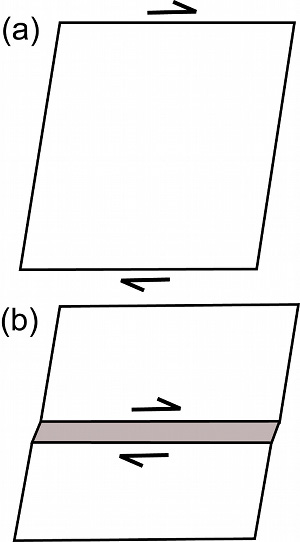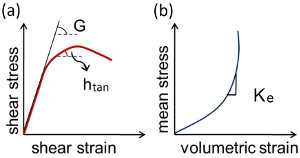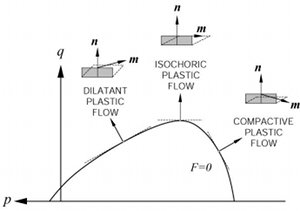| |||||||
|
|
|||||||
|
|
|||||||
| Mechanisms and Mechanics of Deformation Bands | |||||||
|
A product of strain localization into a band-like zone whose thickness is much smaller than the other two dimensions is called a deformation band. An instability in homogeneous deformation (Figure 1a) leading to a localized deformation (Figure 1b) is believed to be the mechanism responsible for deformation band initiation. Please see the classical pioneering paper by Rudnicki and Rice (1975). This model is commonly referred to as the bifurcation model and the tangent modulus (htan) and elastic shear modulus (G) as defined in Figure 2a are thought to be important parameters in this process.There exist various kinematics of deformation bands, which will be described in more detail under shear bands and volumetric bands, occurring in a wide variety of materials besides rocks, including metals and alloys (Leach, 1985), aluminum foam (Papka and Kyriakides, 1998), and ice (Aydin, 2006). Although the material properties may vary from one case to another, it has been suggested that a high porosity, greater than approximately 15%, is a prerequisite for deformation band formation in porous granular rocks (Antonellini and Aydin, 1994; and Holcomb et al, 2007). For the volumetric deformation band formation, the effective bulk modulus is also thought to be a critical parameter. The so called Cap models (Figure 3), based on a yield surface in the mean (or normal) stress-deviatoric (or shear) stress space known as pq space, describe the onset of deformation bands with various kinematics corresponding to distinctly different loading paths. The plastic strain increments are characterized by the relative velocity jump of the two sides of bands, 'm,' and the unit normal of the band planes, 'n.' The scalar products of 'm' and 'n' are equal to 1, 0, and -1 and correspond to pure dilation, simple shear (isochoric shear), and pure compaction, respectively (Borja and Aydin, 2004). The yield surface or the failure envelope has dilatant side (positive; 0 < m*n <1) and compactive side (negative; -1 < m*n < 0) and the bands corresponding to these sides may be dilatant and compactive shear bands, respectively, or shear enhanced dilation bands and shear enhanced compaction bands depending on the relative magnitudes of the shear and volumetric components of the deformation (Aydin et al., 2006; and Fossen et al., 2007). Other models such as anti-crack, inclusion, and localized volume reduction are referred to under 'Mechanisms and Mechanics of Volumetric Deformation Bands' and 'Mechanisms and Mechanics of Pressure Solution Seams.' | |||||||
| Types of Mechanisms and Mechanics of Deformation Bands: | |||||||
| Mechanisms and Mechanics of Volumetric BandsMechanisms and Mechanics of Shear Bands Mechanisms and Mechanics of Deformation Band ZonesMechanisms and Mechanics of Deformation Band SetsMechanisms and Mechanics of Multiple Deformation Band SetsMechanisms and Mechanics of Deformation Band Domains | |||||||
| Reference: |
|||||||
| Antonellini, M., Aydin, A., 1994 Aydin, A., Johnson, A.M., 1983 Aydin, A., Borja, R., Eichhubl, P., 2006 Aydin, A., Borja, R., Eichhubl, P., 2006 Aydin, A., 2006 Borja, R., Aydin, A., 2004 Fossen, H., Schultz, R.A., Shipton, Z.K., Mair, K., 2007 Holcomb, D., Rudnicki, J.W., Issen, K.A., Sternlof, K.R., 2007 Leach, P.W., 1985 Papka, S.D., Kyriakides, S., 1998 Rudnicki, J.W., Rice, J.R., 1975 |
|||||||
|
Readme | About Us | Acknowledgement | How to Cite | Terms of Use | Ⓒ Rock Fracture Knowledgebase |
|||||||


